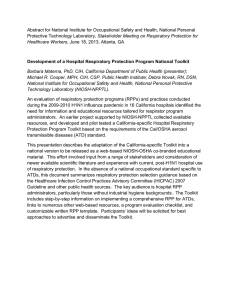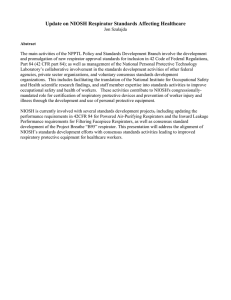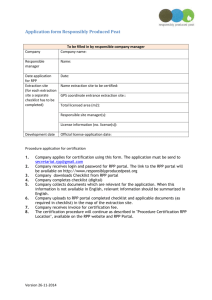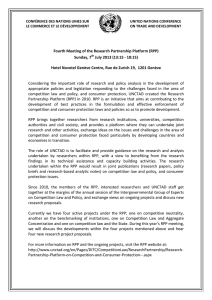CBRN Respiratory Protection Program Designs Terrence K. Cloonan NPPTL, NIOSH, CDC, DHHS
advertisement
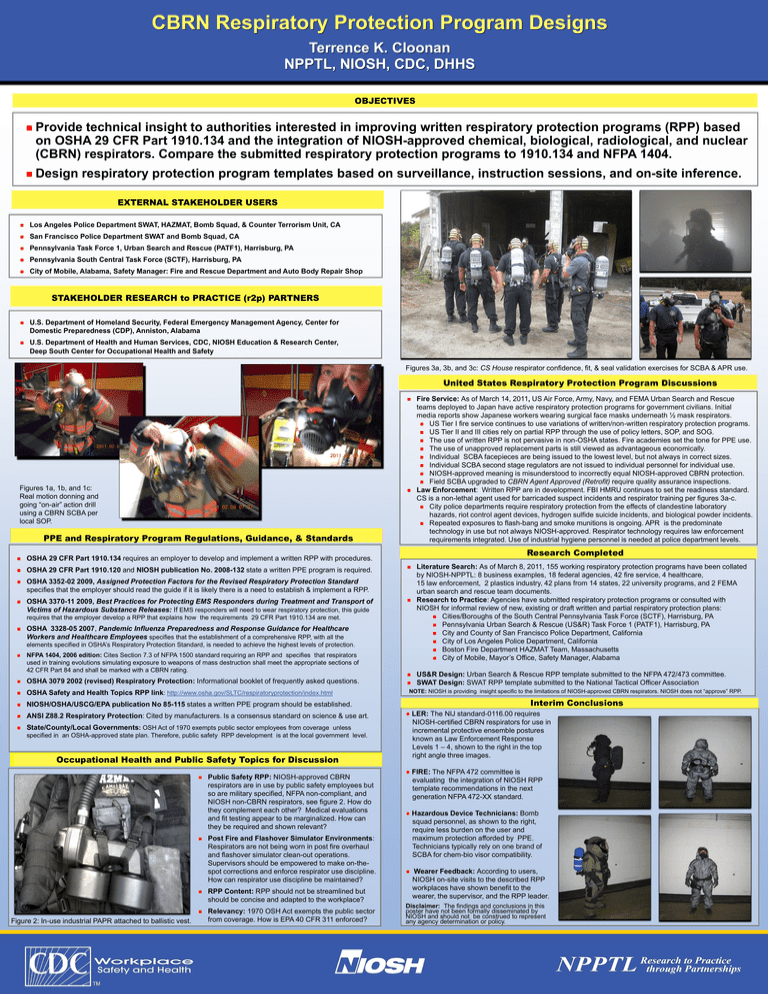
CBRN Respiratory Protection Program Designs Terrence K. Cloonan NPPTL, NIOSH, CDC, DHHS OBJECTIVES Provide technical insight to authorities interested in improving written respiratory protection programs (RPP) based on OSHA 29 CFR Part 1910.134 and the integration of NIOSH-approved chemical, biological, radiological, and nuclear (CBRN) respirators. Compare the submitted respiratory protection programs to 1910.134 and NFPA 1404. Design respiratory protection program templates based on surveillance, instruction sessions, and on-site inference. EXTERNAL STAKEHOLDER USERS Los Angeles Police Department SWAT, HAZMAT, Bomb Squad, & Counter Terrorism Unit, CA San Francisco Police Department SWAT and Bomb Squad, CA Pennsylvania Task Force 1, Urban Search and Rescue (PATF1), Harrisburg, PA Pennsylvania South Central Task Force (SCTF), Harrisburg, PA City of Mobile, Alabama, Safety Manager: Fire and Rescue Department and Auto Body Repair Shop STAKEHOLDER RESEARCH to PRACTICE (r2p) PARTNERS U.S. Department of Homeland Security, Federal Emergency Management Agency, Center for Domestic Preparedness (CDP), Anniston, Alabama U.S. Department of Health and Human Services, CDC, NIOSH Education & Research Center, Deep South Center for Occupational Health and Safety Figures 3a, 3b, and 3c: CS House respirator confidence, fit, & seal validation exercises for SCBA & APR use. United States Respiratory Protection Program Discussions Figures 1a, 1b, and 1c: Real motion donning and going “on-air” action drill using a CBRN SCBA per local SOP. PPE and Respiratory Program Regulations, Guidance, & Standards OSHA 29 CFR Part 1910.134 requires an employer to develop and implement a written RPP with procedures. OSHA 29 CFR Part 1910.120 and NIOSH publication No. 2008-132 state a written PPE program is required. OSHA 3352-02 2009, Assigned Protection Factors for the Revised Respiratory Protection Standard specifies that the employer should read the guide if it is likely there is a need to establish & implement a RPP. OSHA 3370-11 2009, Best Practices for Protecting EMS Responders during Treatment and Transport of Victims of Hazardous Substance Releases: If EMS responders will need to wear respiratory protection, this guide Research Completed requires that the employer develop a RPP that explains how the requirements 29 CFR Part 1910.134 are met. OSHA 3328-05 2007, Pandemic Influenza Preparedness and Response Guidance for Healthcare Workers and Healthcare Employees specifies that the establishment of a comprehensive RPP, with all the elements specified in OSHA’s Respiratory Protection Standard, is needed to achieve the highest levels of protection. NFPA 1404, 2006 edition: Cites Section 7.3 of NFPA 1500 standard requiring an RPP and specifies that respirators used in training evolutions simulating exposure to weapons of mass destruction shall meet the appropriate sections of 42 CFR Part 84 and shall be marked with a CBRN rating. OSHA 3079 2002 (revised) Respiratory Protection: Informational booklet of frequently asked questions. OSHA Safety and Health Topics RPP link: http://www.osha.gov/SLTC/respiratoryprotection/index.html NIOSH/OSHA/USCG/EPA publication No 85-115 states a written PPE program should be established. ANSI Z88.2 Respiratory Protection: Cited by manufacturers. Is a consensus standard on science & use art. State/County/Local Governments: OSH Act of 1970 exempts public sector employees from coverage unless specified in an OSHA-approved state plan. Therefore, public safety RPP development is at the local government level. Occupational Health and Public Safety Topics for Discussion Figure 2: In-use industrial PAPR attached to ballistic vest. Public Safety RPP: NIOSH-approved CBRN respirators are in use by public safety employees but so are military specified, NFPA non-compliant, and NIOSH non-CBRN respirators, see figure 2. How do they complement each other? Medical evaluations and fit testing appear to be marginalized. How can they be required and shown relevant? Post Fire and Flashover Simulator Environments: Respirators are not being worn in post fire overhaul and flashover simulator clean-out operations. Supervisors should be empowered to make on-thespot corrections and enforce respirator use discipline. How can respirator use discipline be maintained? RPP Content: RPP should not be streamlined but should be concise and adapted to the workplace? Relevancy: 1970 OSH Act exempts the public sector from coverage. How is EPA 40 CFR 311 enforced? Fire Service: As of March 14, 2011, US Air Force, Army, Navy, and FEMA Urban Search and Rescue teams deployed to Japan have active respiratory protection programs for government civilians. Initial media reports show Japanese workers wearing surgical face masks underneath ½ mask respirators. US Tier I fire service continues to use variations of written/non-written respiratory protection programs. US Tier II and III cities rely on partial RPP through the use of policy letters, SOP, and SOG. The use of written RPP is not pervasive in non-OSHA states. Fire academies set the tone for PPE use. The use of unapproved replacement parts is still viewed as advantageous economically. Individual SCBA facepieces are being issued to the lowest level, but not always in correct sizes. Individual SCBA second stage regulators are not issued to individual personnel for individual use. NIOSH-approved meaning is misunderstood to incorrectly equal NIOSH-approved CBRN protection. Field SCBA upgraded to CBRN Agent Approved (Retrofit) require quality assurance inspections. Law Enforcement: Written RPP are in development. FBI HMRU continues to set the readiness standard. CS is a non-lethal agent used for barricaded suspect incidents and respirator training per figures 3a-c. City police departments require respiratory protection from the effects of clandestine laboratory hazards, riot control agent devices, hydrogen sulfide suicide incidents, and biological powder incidents. Repeated exposures to flash-bang and smoke munitions is ongoing. APR is the predominate technology in use but not always NIOSH-approved. Respirator technology requires law enforcement requirements integrated. Use of industrial hygiene personnel is needed at police department levels. Literature Search: As of March 8, 2011, 155 working respiratory protection programs have been collated by NIOSH-NPPTL: 8 business examples, 18 federal agencies, 42 fire service, 4 healthcare, 15 law enforcement, 2 plastics industry, 42 plans from 14 states, 22 university programs, and 2 FEMA urban search and rescue team documents. Research to Practice: Agencies have submitted respiratory protection programs or consulted with NIOSH for informal review of new, existing or draft written and partial respiratory protection plans: Cities/Boroughs of the South Central Pennsylvania Task Force (SCTF), Harrisburg, PA Pennsylvania Urban Search & Rescue (US&R) Task Force 1 (PATF1), Harrisburg, PA City and County of San Francisco Police Department, California City of Los Angeles Police Department, California Boston Fire Department HAZMAT Team, Massachusetts City of Mobile, Mayor’s Office, Safety Manager, Alabama US&R Design: Urban Search & Rescue RPP template submitted to the NFPA 472/473 committee. SWAT Design: SWAT RPP template submitted to the National Tactical Officer Association NOTE: NIOSH is providing insight specific to the limitations of NIOSH-approved CBRN respirators. NIOSH does not “approve” RPP. Interim Conclusions ● LER: The NIJ standard-0116.00 requires NIOSH-certified CBRN respirators for use in incremental protective ensemble postures known as Law Enforcement Response Levels 1 – 4, shown to the right in the top right angle three images. ● FIRE: The NFPA 472 committee is evaluating the integration of NIOSH RPP template recommendations in the next generation NFPA 472-XX standard. ● Hazardous Device Technicians: Bomb squad personnel, as shown to the right, require less burden on the user and maximum protection afforded by PPE. Technicians typically rely on one brand of SCBA for chem-bio visor compatibility. ● Wearer Feedback: According to users, NIOSH on-site visits to the described RPP workplaces have shown benefit to the wearer, the supervisor, and the RPP leader. Disclaimer: The findings and conclusions in this poster have not been formally disseminated by NIOSH and should not be construed to represent any agency determination or policy.
